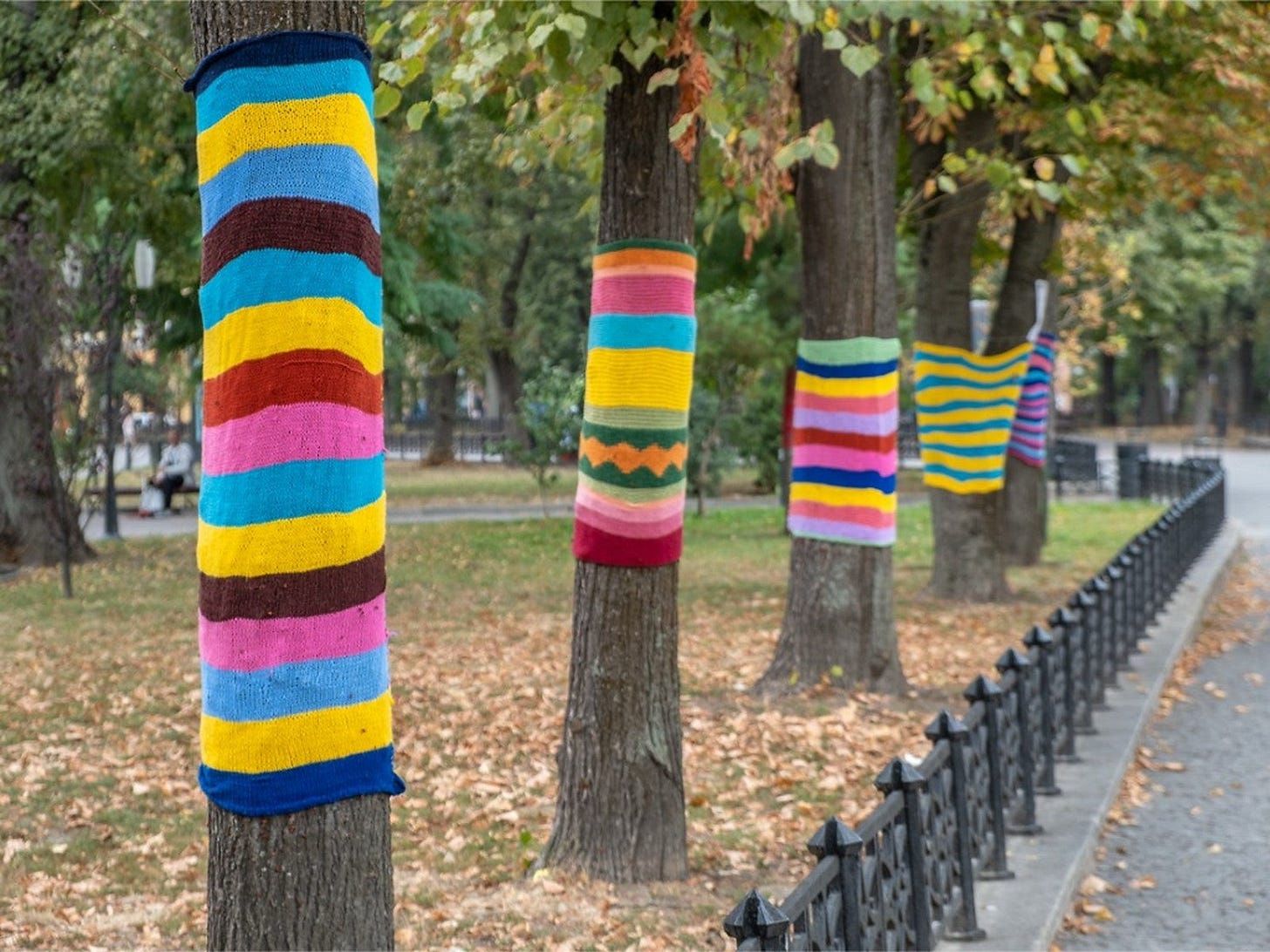Wonderfully Pointless Hobbies
A celebration of wonderfully pointless hobbies like air guitar, worm charming, and watching paint dry. Useless? Absolutely. Meaningful? Somehow, yes.
Some people run marathons. Others climb corporate ladders, scale mountains, write novels, or at least pretend to. Most people spend their hours chasing something: money, status, enlightenment, abs. We applaud them, not necessarily because we understand them, but because they make for good conversation at dinner parties. Purpose is an acceptable addiction, and nothing says well-adjusted quite like the visible grind of becoming something. The rest of us, however, understand that time doesn’t need to be conquered. It just needs to be occupied - preferably with something that confuses others and embarrasses your children.
There is, we believe, a peculiar dignity in wasting time well. Not squandering it exactly, but setting it gently adrift, like a paper boat on a lazy river. This is not idleness, mind you. These pursuits require effort, commitment, sometimes even specialized equipment of unclear origin. They are undertaken not out of laziness but from a deeper compulsion - one that resists explanation and resents efficiency. There is no five-year plan. There may not even be a five-minute one. These are the sorts of endeavors that begin without fanfare and end when you forget why you started in the first place.
To call them hobbies feels both accurate and insufficient. A hobby implies leisure, a kind of pleasant filler between obligations. But these are different. They are absurd, yes - but absurdity approached with the solemn intensity usually reserved for religious rites and IKEA assembly manuals.
These are not things one does for anything. They do not improve the body, enhance the resume, or reveal hidden depths. They will not get you published, promoted, or even particularly noticed. They offer no clear path to mastery or reward. And yet, people do them. Endlessly, joyfully, with a purpose known only to them.
Which brings us, naturally, to the matter at hand: a brief tour of hobbies so wonderfully pointless, they almost loop back around to profound. Not because they serve a function, but because they refuse to.
Also known as yarn bombing it’s what happens when crafters go rogue. It involves wrapping everyday public objects - benches, statues, bike racks, trees, traffic signs - in knitted or crocheted coverings.
Think of it as street art in a softer key: graffiti, but with better manners and a fondness for pastels. No walls defaced, no permanence asserted. Just wool, whimsy, and the quiet thrill of unauthorized coziness.
It’s believed to have originated in Texas (a place not generally associated with needlework subversion) in the early 2000s. But from there it spread, one stitch at a time, into cities around the world. Part of its charm lies in the contradiction: the intimate, domestic act of knitting projected onto the impersonal canvas of urban infrastructure. A parking meter becomes a totem pole in stripes. A tree trunk acquires legwarmers. A statue gains some modesty and flair.
Urban knitting is pointless in the most satisfying way. It serves no function, makes no money, and solves no discernible problem. But it does gently upend our expectations of public space. It asks: what if infrastructure were...hugged? It’s not protest, exactly, but it does seem to mutter something under its breath about the sterility of modern life.
In spirit, if not in scale, urban knitters might be seen as the wool-wielding grandchildren of Christo and Jeanne-Claude - the artists who famously wrapped bridges, coastlines, and government buildings in fabric.
Where Christo swathed monuments in grandeur, yarn bombers do it in whimsy. But both ask the same sly question: what if we just...wrapped the whole thing? And to what end? None, really. Which is the point.
Competitive duck herding originated, as many peculiar things do, in the English countryside. It sounds like a pastime invented by someone mid-pint, but is, in fact, a real and organized activity - complete with rules, techniques, and a level of seriousness that feels almost satirical. The premise is straightforward: a person (often with the help of a Border Collie) attempts to guide a small flock of ducks through a series of obstacles.
Gates, cones, miniature bridges - essentially an avian agility course, only with creatures who are less “obedient livestock” and more “wet, flapping question marks.”
Unlike sheep, ducks do not particularly enjoy being herded. They do not respond to firm whistles or assertive shouts with any consistency. They respond, instead, with what can only be described as group skepticism. This makes the sport less a demonstration of control and more a public exercise in humility. Success, when it happens, is a delicate dance of timing, strategy, and politely negotiating with animals that neither understand nor respect your goals.
It has become a fixture at British country fairs and increasingly at corporate team-building events, where the symbolism of trying to align a group of confused individuals toward a common objective is perhaps a little too on-the-nose. There is pageantry. There are judges. There are, occasionally, tuxedoed ducks.
Whether it’s a sport, a spectacle, or performance art is frankly up for debate - and beside the point.
In its own baffling way, competitive duck herding captures everything noble about a pointless hobby. It requires practice, patience, and a total suspension of dignity. It’s choreography with birds who couldn’t care less. And yet, the joy is real. The stakes are nonexistent. And somewhere, amid the flurry of feathers and flustered commands, a tiny voice whispers: this is absurd - and therefore wonderful.
The Air Guitar Championships are, at heart, an elaborate global joke - one that somehow became a legitimate art form. They began in Finland, where the World Air Guitar Championships have been held annually since 1996, under the guiding philosophy that “wars would end and climate change would stop if everyone just played air guitar.” It’s hard to argue with the logic. After all, it’s a competitive event in which no actual instrument is involved, and yet the performances are often more intense than anything you'd see at a real concert.
Participants take to the stage with the confidence of rock gods and the equipment of imaginary friends. They strut, sweat, leap from amplifiers that aren’t there, and shred solos on fretboards made entirely of mime and delusion. Judges score on technical merit, stage presence, and something called “airness” - a quality best described as the ineffable brilliance of pretending to play a guitar better than someone who actually can.
Of course, it's ridiculous. That's the point. The championship is a celebration of pure performance untethered from reality - music with none of the music, talent without any tangible proof. And yet the dedication is real. Competitors rehearse in front of mirrors, study actual solos note for note, and perfect their windmill strums and knee slides as if the fate of the free world depended on it.
What makes air guitar so wonderfully pointless is precisely what makes it enduring: it’s a communal act of make-believe, a parody that becomes oddly profound. It’s not about being the best musician. It’s about embodying the idea of music so fully that reality becomes a secondary concern. In that sense, it’s less a hobby and more a philosophy - one that suggests the things that matter most don’t necessarily always have to exist in the first place.
Traditionally, a metaphor for supreme tedium - the cultural shorthand for time wasted in its purest form. And yet, in the glorious pantheon of pointless hobbies, watching paint dry has been reimagined not just as performance, but as protest, endurance art, and occasionally, sincere fascination. There are, in fact, actual competitions where people compete to do exactly that: sit, silently, and observe paint as it... dries.
The rules are simple: you sit, you stare, you don’t look away. Blinking is permitted; checking your phone is not. The winner is usually the one who manages to endure the longest without losing focus or visibly questioning the decisions that led them there. It’s less a test of patience than a full-on existential meditation. Some participants describe the experience as “surprisingly calming,” which is precisely what someone who has bonded with emulsion over six hours might say.
The British, naturally, have formalized this into an annual event, where contestants gather to observe freshly painted walls under artificial lighting, sometimes narrating the process with the hushed reverence of nature documentaries. ("Ah, the first signs of matte absorption near the skirting board...")
It’s absurd, of course. But it also asks a very sly question: what is so wrong with doing absolutely nothing, on purpose?
In a world desperate for productivity, watching paint dry becomes a small act of rebellion. It offers no thrill, no spectacle, no badge. But it does offer stillness - pure, unapologetic stillness. And in that silence, one might just discover that time wasted isn't always time lost. Sometimes it's just time... finally left alone.
Learning to play the theremin is the musical equivalent of trying to thread a needle while wearing oven mitts - blindfolded - during an earthquake. It is one of the only instruments played entirely without touch, which sounds elegant in theory but in practice feels like conducting an invisible orchestra of drunk ghosts. You wave your hands near two metal antennas - one controlling pitch, the other volume - and with the slightest miscalculation, your haunting sci-fi melody becomes a squealing banshee in the night.
Invented in the 1920s by Russian physicist Léon Theremin, the instrument gained fame through eerie film scores and the occasional avant-garde concerto.
But actually learning to play it requires a kind of monk-like control over your own body. Every muscle twitch, every involuntary breath, affects the sound. To master the theremin is to master the self, or at least to develop the hand-eye coordination of someone diffusing a bomb in zero gravity.
Naturally, this makes it a terrible hobby for anyone who enjoys immediate gratification. There are no frets to press, no keys to strike - just you, the void, and the sound of your own frustration reverberating in unearthly tones. And yet, its difficulty is part of the appeal. There's something both maddening and noble about devoting hundreds of hours to coaxing music out of empty air, especially when the result is still, inevitably, a bit weird.
But that’s the joy of it. The theremin doesn't care if you ever get good. It offers no shortcuts, no feedback beyond the shriek or warble it gives in return. It is pointless, impractical, and deeply uncool. And that, paradoxically, makes it one of the purest hobbies around - an earnest conversation with something invisible, where the only thing at stake is the sound you almost made.
Giant pumpkin boat racing is exactly what it sounds like, which is to say: completely insane. It involves hollowing out an absurdly oversized gourd - typically weighing hundreds of pounds - then climbing inside to paddle it across a body of water. Not for money. Not for survival. But simply because someone, somewhere, once looked at a pumpkin the size of a small bathtub and thought, “Yes. I shall row this”.
The tradition, if you can call it that, has taken root in places as far apart as Nova Scotia and Oregon, where growers already devote months of care to coaxing their gourds into grotesque proportions. Once harvested, the pumpkin is carved out like a canoe, painted (often with unnecessary enthusiasm), and launched into a lake, along with its increasingly damp pilot. There are costumes.
There are cheers. There is a surprising amount of physics involved - buoyancy, balance, and the awkward realization that pumpkins are not known for their hydrodynamics.
The race itself is somewhere between athleticism and slapstick. Competitors paddle furiously while trying not to spin in slow circles or capsize entirely, which happens often and to great applause. The pumpkins, never designed for maritime activity, bob and lurch like sea monsters in slow decline. It is both a test of determination and a celebration of seasonal absurdity.
And yet, for all its silliness, pumpkin boat racing has a peculiar kind of majesty. It takes agricultural obsession, mixes it with nautical folly, and stirs in just enough lunacy to float. It is an ode to the gloriously pointless - proof that with enough enthusiasm, even a squash can become a vessel for dreams. Wet, wobbly dreams. But dreams nonetheless.
Speedcubing is the competitive art - and yes, it is an art - of solving a Rubik’s Cube faster than most people can open a bag of chips. It’s a world where milliseconds matter, where fingers move in a blur, and where the smug satisfaction of finishing a cube becomes a full-contact mental sport, complete with judges, timers, and nervous applause. What was once the frustrating desk ornament of the 1980s has been transformed into a sleek instrument of high-speed wizardry.
The top speedcubers don’t so much solve the cube as dismantle reality in front of your eyes. They use algorithms - actual, memorized algorithms - with names like “F2L” and “OLL” that sound like malfunctioning printers but are, in fact, the building blocks of an astonishingly complex subculture. A beginner might spend weeks trying to line up one side. A pro will solve the entire cube in under five seconds, often with a grim focus that suggests they're trying to defuse a bomb at a children’s birthday party.
There are national and international championships, unofficial rivalries, and YouTube channels dedicated to finger placement, cube lubrication (yes, that’s a thing), and the best color schemes for optimal visual processing. Cubes themselves have evolved into high-tech devices with magnets, tension-adjustment systems, and price tags that suggest someone is taking this very seriously.
And yet, the joy of speedcubing is refreshingly pure. There's no cash prize big enough to justify hours of staring at color patterns under fluorescent lighting. It’s just effort for effort’s sake - precision without purpose, except to shave a tenth of a second off your time. In a world demanding meaning at every turn, speedcubing offers the quiet thrill of mastery with absolutely no moral attachment. It doesn’t build character. It just solves cubes. Very, very fast.
For our regular and loyal readers, you may recall we talked about this in our “Super Bowl Options” post from February of 2024. But we’re including it here again because we think it’s truly worth mentioning again. This is the hobby that took one look at domestic labor and thought, what if we made it more dangerous and less practical? It has categories like underwater ironing (full scuba gear, crisp cuffs), alpine ironing (oxygen optional), ironing on a kayak (balance required, dignity optional), and, most notoriously, mid-skydive ironing - which involves leaping from a plane while trying to smooth out a wrinkled button-down before gravity and panic set in.
It’s part sport, part performance art, part nervous breakdown in athletic wear.
No one asked for this, and yet here it is - organized, international, and alarmingly sincere. Participants haul ironing boards into forests, glaciers, and volcano rims as if fabric care were an extreme survival skill. And somewhere, in the absurdity of it all, lies the real genius: taking one of the most mundane chores imaginable and turning it into a spectacle of absurd commitment. There are no points, no real prizes, just the satisfaction of having pressed linen where no linen has been pressed before.
It’s pointless in the most poetic sense - a pursuit with no finish line, no market value, and no logical origin story. Just a community of people who decided that if they must suffer through ironing, they might as well do it dangling from a cliff in the Scottish Highlands. It doesn’t solve a problem. It is the problem. Which, of course, makes it perfect.
Also known as worm grunting or worm fiddling - is the genteel countryside sport of coaxing earthworms out of the ground using nothing but rhythm, ingenuity, and a deep belief that dirt can be reasoned with. There are no shovels involved, no digging. That would be crude. Instead, participants use vibration - stomping, twanging, tapping, or playing music near the soil - to trick worms into thinking it’s raining or that a mole is coming, both of which inspire a swift, panicked surfacing.
The practice has roots in rural folklore - and a fisherman’s need for bait - but has since evolved into full-fledged competitions. The first organized competition, the World Worm Charming Championships, began in 1980 at Willaston, England. The rules are simple: you’re assigned a patch of earth, a time limit (usually 30 minutes), and the rest is up to you. Some competitors bang metal rods. Others strum guitars or the instruments of their choice.
Innovation is encouraged, dignity, as you can see, is optional.
Worms, for their part, remain pretty unimpressed. They surface reluctantly, sporadically, and with the vague air of being inconvenienced. Success is measured by the number of worms charmed out of hiding and gently placed in a bucket. The current world record, by the way, is 567 worms in 30 minutes - set by a ten-year-old girl in Cheshire, England. Make of that what you will.
Worm charming is the purest kind of absurdity: a battle of wills between human creativity and soil-dwelling invertebrates. It requires patience, imagination, and the ability to stand in a field making strange noises while pretending you’re not completely losing your mind. But at its heart, it’s a celebration of doing something strange just because it’s fun. And that, in a world obsessed with outcomes, might be the most charming thing of all.
We live in a world engineered to be useful. Every minute tracked, every hobby monetized, every interest turned into a side hustle until there's nothing left but spreadsheets and burnout. We’re told to optimize our lives like we’re some kind of badly managed logistics firm. And maybe that’s why these hobbies - these gloriously useless, time-devouring, unprofitable pursuits - feel not just refreshing, but quietly radical.
Because none of this makes sense. And that’s exactly the point. Nobody needs to herd ducks or race in a hollowed-out squash or iron a shirt on top of a mountain. No one wakes up thinking, I must knit a sweater for this tree. And yet, people do. Not to get ahead. Not to be seen. But because it’s weird, and fun, and sometimes just wonderfully dumb. Which, in an age where everyone’s pretending to have it all figured out, is weirdly noble.
There’s something deeply human about caring too much about something that doesn’t matter. About putting time and effort into a thing that offers no reward other than the doing. It’s not ambition. It’s not ego. It’s just... devotion. Unreasonable, joyful devotion. And if that’s not the best kind of madness, we don’t know what is.
So here’s to the ones speed-solving cubes in fluorescent-lit conference rooms. To the worm whisperers and air guitar gods. To the dry paint watchers, the kayak ironers, and the soft-hearted urban knitters. You may not be changing the world - but you’re certainly making it weirder, softer, and a hell of a lot more interesting.




























